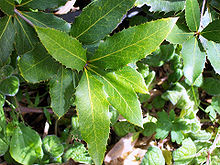Eidothea hardeniana
| Eidothea hardeniana | |
|---|---|

| |
| Nightcap oak leaves at Royal Botanic Gardens, Sydney | |
Conservation status
| |
| Scientific classification | |
| Kingdom: | Plantae |
| Clade: | Tracheophytes |
| Clade: | Angiosperms |
| Clade: | Eudicots |
| Order: | Proteales |
| Family: | Proteaceae |
| Genus: | Eidothea |
| Species: | E. hardeniana
|
| Binomial name | |
| Eidothea hardeniana | |
Eidothea hardeniana, commonly named nightcap oak, is a species of tree, up to 40 m (130 ft) tall, of the plant family Proteaceae, which botanist Robert Kooyman recognised as a new species only recently in 2002.[3][5][6] The species has an official listing as critically endangered on the Australian Commonwealth EPBC Act and as Endangered on the NSW Threatened Species Act.[2][5] The name hardeniana honours the botanist Gwen Harden. Phylogenetics studies now suggest it represents a basal branch of the Proteoid clade of the Proteaceae.
Distribution and habitat[]
The trees are only known to grow naturally in a single creek catchment in warm temperate rainforest in the Nightcap Range, northern New South Wales, Australia. They grow naturally in relatively poor, acidic volcanic soils, in an area of a high rainfall. Only around 100 wild plants are known.[3][6] Plants are in cultivation, including in the Royal Botanic Gardens, Sydney.
Much of its habitat was devastated by bushfire in 2019–20.[7] However, the plant has the ability to survive fires by coppicing itself as well as reproducing with its large seeds, and less than a fifth are thought to have died.[8]
Description[]
Eidothea hardeniana trees have pale lichen covered bark typical of many species in the Warm Temperate Rainforests. Often a ring of coppice shoots surrounds the base of an adult tree, coppice and seedling leaves have spiny marginal teeth, while adult leaves have no teeth.[3]
Flowers are cream, occur in clusters and smell of aniseed.
Fruits are large and rounded with a yellow green skin and a hard nut inside. The walls of the nut are ribbed, a feature unique to this genus in the family. The seed has a white center and it probably contains poisonous cyanogenic compounds like some species of Macadamia.[citation needed] These toxins do not deter rodents from eating through the hard nut and devouring the seeds, limiting the regeneration of this plant.
Flower photos[]
Un-opened buds
Flowers
Flowers
Flower growing directly from the main stem
References[]
- ^ Forster, P., Ford, A., Griffith, S. & Benwell, A. 2020. Eidothea hardeniana. The IUCN Red List of Threatened Species 2020: e.T112631200A113309140. https://dx.doi.org/10.2305/IUCN.UK.2020-2.RLTS.T112631200A113309140.en. Downloaded on 26 August 2021.
- ^ Jump up to: a b Eidothea hardeniana – Nightcap Oak, Species Profile and Threats Database, Department of the Environment and Heritage, Australia. Retrieved 14 Dec 2013
- ^ Jump up to: a b c d Weston, P. H.; Kooyman, R. M. (2002). "Systematics of Eidothea (Proteaceae), with the description of a new species, E. hardeniana, from the Nightcap Range, north-eastern New South Wales". Telopea. 9 (4): 821–832. doi:10.7751/telopea20024022.
- ^ "Eidothea hardeniana P.H.Weston & Kooyman". Australian Plant Name Index (APNI), IBIS database. Centre for Plant Biodiversity Research, Australian Government. Retrieved 10 Nov 2013.
- ^ Jump up to: a b NSW Department of Environment and Conservation (2004). National Recovery Plan for the Nightcap Oak (Eidothea hardeniana). Hurstville, New South Wales: Department of Environment and Conservation. ISBN 0-7313-6781-2. Retrieved 10 Nov 2013.
- ^ Jump up to: a b Weston, P. H.; Kooyman, R. M. (2002). "Eidothea hardeniana- Botany and Ecology of the 'Nightcap Oak'". Australian Plants. Australian Plants Society. 21: 339–342. Archived from the original on 2013-11-10.
- ^ Shoebridge, Joanne; Marciniak, Catherine (18 January 2020). "Gondwana-era rainforest stand of nightcap oak devastated by unprecedented bushfire". ABC News. Australian Broadcasting Corporation. Retrieved 18 January 2020.
- ^ "Precious nightcap oak survives the carnage of bushfire with show of uplifting resilience". www.abc.net.au. 2020-06-14. Retrieved 2021-08-24.
External links[]
 Media related to Eidothea hardeniana at Wikimedia Commons
Media related to Eidothea hardeniana at Wikimedia Commons- National Recovery Plan (PDF file)
- IUCN Red List critically endangered species
- EPBC Act critically endangered biota
- Critically endangered flora of Australia
- Proteaceae
- Proteales of Australia
- Flora of New South Wales
- Trees of Australia





